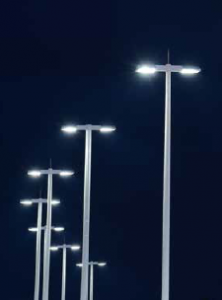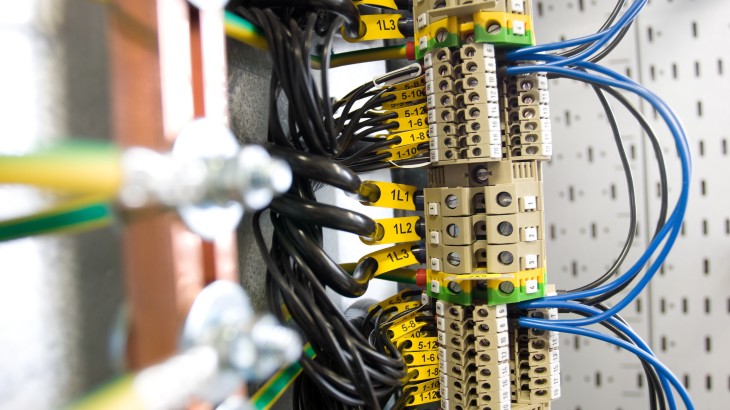IHS Technologies, a global provider of market, industry, and technical expertise, has created a comprehensive list of the top ten lighting trends for 2015. In this post, we’ll break down each and share our thoughts.
1. China—the LED dragon—continues to grow
Over the past few years, the Chinese LED market has grown rapidly. MLS Electronics, a Chinese-based LED manufacturing company, is currently the largest LED company in the world. With tens of thousands of other lighting companies, China is one of the world’s largest production bases. China’s ability to produce up to 10 million LED bulbs per month in some of its larger companies, and its low cost competitive advantage, is putting all eyes on the Chinese LED market. Quantitatively speaking, China’s lighting market is expected to reach $20B by 2015 with a market share of 18.3%, according to a new report by Lighting.com
2. Sky’s the limit for cloud-based smart lighting
Cloud computing with remote lighting optimization is the future. Functionality with lighting controls and automation, including switching, dimming, and color-tuning specific areas of a facility, are giving facility managers more power to remotely monitor occupancy, energy consumption, and system usage. Beyond control, cloud-based applications will allow for data analysis, helping to evaluate or diagnose problem areas in buildings to further optimize energy consumption. This technology may still be out of our reach for 2015, but it is an emerging trend that is quickly gaining traction.

3. Changing fortunes for lighting companies in 2015?
Some of the big lighting suppliers—Philips and Siemens AG—recorded declining revenue in 2014. As a potential remedy, Philips split its business into two parts that will continue to work under the Philips brand: HealthTech and Lighting Solutions, each focusing on different business sectors. The move estimates the company will save €300 million into 2016. Philips pursued a similar business strategy to its rival competitor, Siemens AG, who spun off Osram the previous year. The move streamlines the company’s operations, improving profitability, by focusing on specific growth areas. The moves also are in response to upcoming big players in the lighting industry, including Cree and LG. Cree has made significant headway in the industry, recently being recognized as one of the most innovative companies in 2015 by Fast Company.
4. Li-Fi: a brighter way to communicate
After its inception, Wi-Fi revolutionized the way we work and do business, allowing us access to free Internet connections across the globe. Now, Li-Fi attempts to take us to the next level. Li-Fi uses “visible LED light for high-speed data transmission of material such as movies, music, or any other form of data.” In laboratory conditions, researchers were able to achieve transmissions of 10 gigabits per second. That’s ten times faster than Google Fiber’s revolutionary speeds of 1 gigabyte per second. For now, drawbacks still exist, as the technology only works with LED lighting, meaning infrastructure will need to be updated and optimized for the technology to work. Yet, this is an exciting project that could completely change the way we work and do business once again over the next coming years.
5. Is lighting poised for a quantum leap?
Over the past few years, OLEDs (organic light-emitting diodes) have been the next big thing in lighting technology. OLEDs took LED technology and transposed it onto large, flexible panels, allowing for a broader range of applications. While the technology is available, the prices reach up to 50 times more than standard LED lighting solutions, dissolving its applicability through poor cost-effectiveness. Understanding this dilemma, a new challenger entered the ring by the name of “QD.” QD refers to quantum dot, which is being applied to enhance LCD displays. Through this application, QD technology “can be manufactured to emit any color in the visible spectrum,” which “allows for superior color gamut” and is “more efficient than conventional LCDs and even OLED screens.” While this technology is still in its early stages of development, QD-LED technology may change the landscape of the lighting industry, once available products emerge over the next few years.

Image Source:IHS Technologies
6. OLED luminaries, and where to purchase them
Despite the emergence of QD-LED technology, OLEDs are still on the forefront of emerging as the next big thing in the lighting industry. Currently, OLED applications are primarily used in custom-designed projects. OLED panels, however, are experiencing a decrease in price to the point where big box retailers like Home Depot have begun selling OLED luminaires to the public in its online stores. IHS Technologies predicts the price of OLEDs, over the years to come, will continue to fall. We agree. Similar to the initial advancements of LEDs, the law of diminishing returns applies. It took nearly a decade for LED technology to become an every day application in our businesses and homes, and LEDs continue to see declining prices. We do not see why OLED technology will not experience the same trend.
7. LED filament bulbs: incandescent beauty with an LED twist
One drawback to LED lighting is obvious: consumers are used to, and have grown a fondness for, the style and appearance of old incandescent lighting. After the ban of incandescent lighting sales, customers have turned to halogen lamps, which produce a similar look and feel to incandescents. Restaurant owners are especially prone to these purchases to create the right atmosphere for their customers. Unfortunately, LEDs were not an option because they cold not produce the same effect. Until recently. LED filament lamps aim to change this by combining the benefits of LED lamps with the style of incandescent bulbs. “Instead of LED chips arranged on a board or around a corncob, these filaments consist of rows of tiny LEDs on a glass substrate. The glass is covered in yellow phosphor to convert the originally blue light into white . . . .” The filaments can be wired in a series and bundled into one bulb to not only increase brightness, but also lower heat generation and reduce the complexity of the driver circuit.
While halogen lighting is trending due to the incandescent ban, LED manufacturers, especially in companies like Cree, are making advancements to mimic the style and appearance of incandescent lighting, too. Just recently, Cree unveiled a new, ultra-cheap LED that resembles an incandescent bulb. We believe this is another trend that will take off in 2015.
8. Packaged LED industry is moving downstream and getting smarter
Lighting is going through the process of becoming computerized. Manufacturers are working to develop smart lighting systems through vertical integration, focused on chip-on-board, modules, and light engines. What all this means is the ability to incorporate lighting sensors, controls, heat sinks, and optics, ultimately giving a lighting system more versatility. IHS expects integration to improve the supply chain process and profit margins. Ideally, manufacturers seek an immediate step between the integrated and fully completed lamp, to which they can then outsource the rest of the job to the booming Chinese lighting industry at reduced costs.
9. Is your street light all that it seems?
A big push in 2015 and the upcoming years is to improve our municipal lighting systems. After the vastly successful lighting retrofit project in Los Angeles, other cities aim to follow suit. However, there are larger plans for streetlights than simply LED upgrades and control integration. For example, phone companies are interested in communication applications. “By incorporating wireless transmitters or mobile phone masts in street light luminaires, communications providers can take advantage of the spare bandwidth in the wired communication links to the luminaires to provide additional coverage in urban areas.” What’s more, “BMW is piloting a scheme in Munich, where car owners can charge their batteries from the power supplies integrated into the street light luminaire.” Indeed, with the pre-existing street light infrastructure and the Internet of Things connection, there are a lot of exciting opportunities on the horizon.

10. Automotive applications driving optoelectronic components market
Optoelectronics, which is the study and application of electronic devices that source, detect, and control light, has been dominated by backlighting and solid-state lighting within the LED industry over the past few years. These technologies have been adopted into the automotive industry in headlamps and automatic windscreen wipers. According to an IHS Automotive study, less than 5 percent of car headlamps use LEDs; however, that figure is expected to increase to 8 percent in 2015. On a distribution level, IHS predicts LED headlamp shipments to increase to 70 percent in 2015.
Final Thoughts
The lighting industry, including LEDs, OLEDs, and QDs, are expanding rapidly within the U.S. and worldwide. China is leading the way in LED production, which will help spur growth, enhance distribution and trade, and reduce costs going forward. We’re seeing more technological applications becoming integrated into lighting technologies, which will assist residents, businesses, and governments with better energy consumption control. Finally, by mixing in the Internet of Things phenomena into the equation, LEDs and lighting infrastructure may reshape the world we live in over the next decade, starting with new concepts in 2015.




